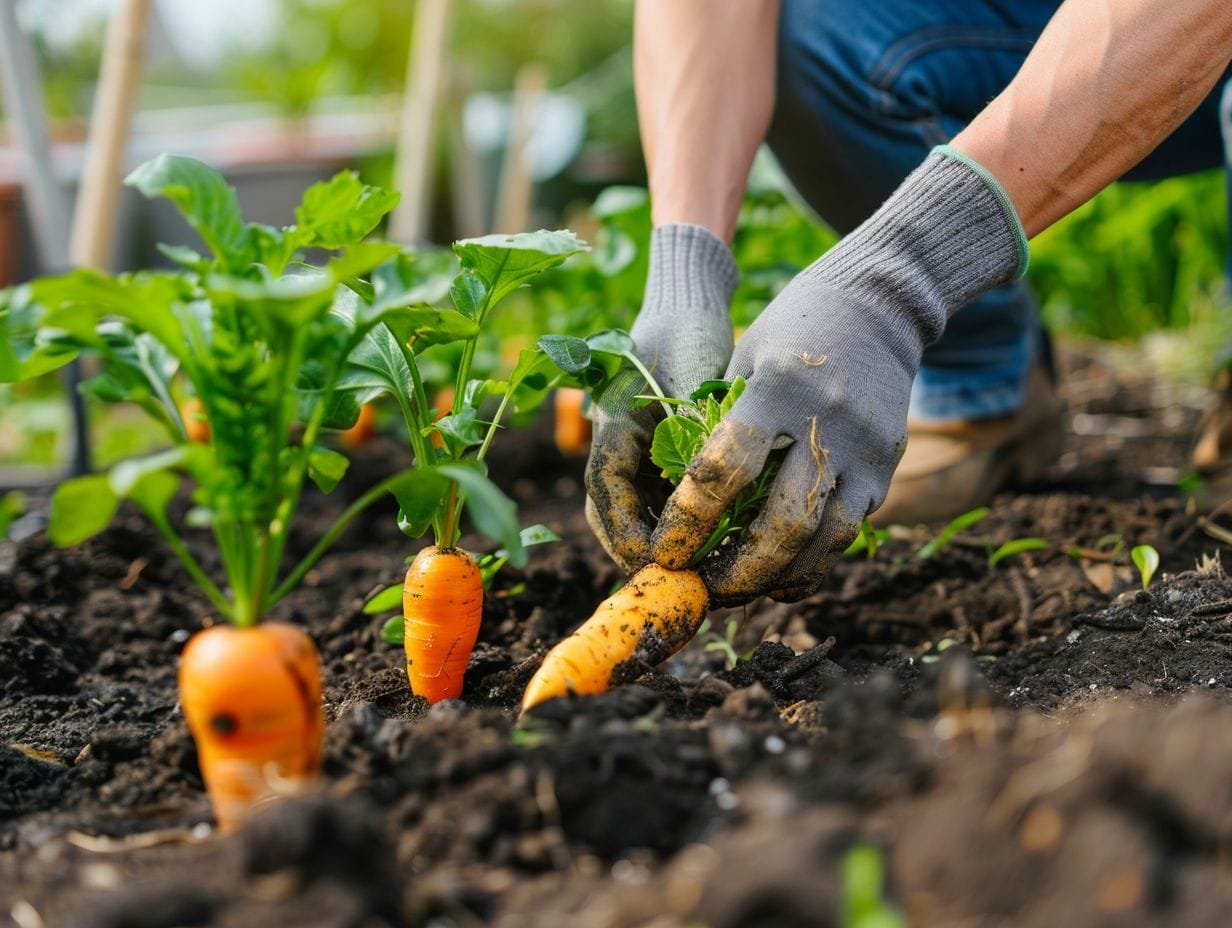In this extensive guide, the benefits of organic gardening, encompassing its environmental and health advantages, will be thoroughly examined. The planning of an organic garden will be elucidated, beginning with the selection of an appropriate location and the consideration of plants and layouts.
Moreover, the significance of maintaining healthy soil and strategies for enhancing its quality will be discussed. Guidance on garden care, specifically pertaining to organic pest control and adequate watering methods, will be provided. Additionally, insight into harvesting and preserving organic produce will be shared.
Thus, individuals will be equipped to commence their own environmentally sustainable garden.
What is Organic Gardening?
Organic gardening entails the cultivation of an environmentally sustainable garden through the utilization of natural processes and materials, rendering it an optimal approach for individuals new to creating a more healthful environment.
This gardening methodology, with its centuries-old lineage, is deeply entrenched in the ethos of harmonizing with nature rather than opposing it. By abstaining from synthetic chemicals and pesticides, organic gardeners contribute to the preservation of a harmonious ecosystem that fosters biodiversity. Common practices within organic gardening encompass composting, crop rotation, and the implementation of natural pest control techniques such as companion planting.
The advantages of embarking on an organic gardening journey are manifold. These include the production of more nutritious and flavorsome fruits and vegetables, the mitigation of environmental pollution, and the preservation of water and soil integrity for forthcoming generations.
Benefits of Organic Gardening
The advantages of organic gardening transcend the immediate benefits of cultivating an environmentally friendly garden; they encompass the promotion of sustainable practices, enhancement of soil health, and provision of substantial health benefits for both gardeners and consumers.
Environmental Benefits
Organic gardening practices play a vital role in environmental stewardship by contributing to biodiversity enhancement, fostering eco-conscious methodologies, and ensuring the sustainable utilization of resources.
Through the exclusion of synthetic pesticides and fertilizers, organic gardening effectively preserves soil health, fostering an environment conducive to the thriving of beneficial microbes and organisms. This, in turn, results in enhanced soil structure, increased water retention, and improved nutrient availability – all of which are key factors for sustainable plant development.
Moreover, organic gardens employ techniques such as composting and mulching to conserve water by minimizing evaporation and improving soil moisture retention. The diverse range of plant species in organic gardens serves as both a habitat and food source for pollinators like bees and butterflies, as well as for beneficial insects that naturally regulate pest populations.
Health Benefits
Organic gardening provides a multitude of health benefits, ranging from the consumption of nutrient-rich homegrown produce and organic herbs to engaging in therapeutic gardening activities that enhance mental well-being.
The physical exertion required in maintaining an organic garden contributes to an active lifestyle and fosters overall fitness. Studies have demonstrated that individuals who engage in gardening activities on a regular basis experience reduced stress levels and improved mental health. Spending time outdoors and connecting with nature while nurturing plants can alleviate anxiety and enhance mood. Additionally, cultivating fruits and vegetables organically guarantees that the produce is devoid of harmful chemicals, thereby offering a healthier option for consumption.
Planning Your Organic Garden
The process of organizing an organic garden requires meticulous deliberation of multiple factors including site selection, plant variety, and garden arrangement to establish an environmentally conscious garden that aligns with sustainable gardening principles.
Choosing a Location
Selecting the appropriate location for your organic garden is of utmost importance, as it is essential to ensure that the site meets the sunlight requirements specific to the plants being cultivated, catering to the needs of both backyard and urban gardening settings.
The level of sunlight exposure plays a critical role in determining the viability of a garden location. It is imperative to verify that the chosen site receives a minimum of 6-8 hours of sunlight daily, particularly for the cultivation of vegetables and flowers. Additionally, it is advisable to evaluate the quality of the soil through a comprehensive soil test to ascertain its pH levels and nutrient composition.
In a backyard gardening context, emphasis should be placed on optimizing space utility and establishing well-defined planting zones. Conversely, for urban gardening environments, it is essential to identify areas with access to water sources and explore the possibility of implementing vertical gardening techniques to maximize productivity within confined spaces.
Deciding on Plants and Layout

The selection of plants and layout planning for an organic garden necessitates a consideration of companion planting principles and the utilization of raised beds to enhance both garden design and plant vitality.
Before selecting plants for the garden, it is imperative to conduct an assessment of the prevailing climate and soil conditions. By carefully evaluating factors such as sun exposure and moisture levels in the designated garden area, one can effectively choose plants that are best suited to thrive in the specific environmental conditions present.
It is prudent to contemplate the compatibility of plants and identify species that complement each other synergistically. For instance, the strategic pairing of marigolds with tomatoes can serve to deter pests and enhance the overall well-being of the crops.
The incorporation of raised beds confers various advantages, including enhanced drainage, improved soil quality, and facilitated access for planting and harvesting activities. It is advisable to organize the garden layout in a manner that optimizes spatial arrangement and sun exposure for each plant, thereby fostering robust growth and facilitating bountiful yields.
Preparing Your Soil
The preparation of soil is a foundational aspect of organic gardening. Maintaining soil health through practices like composting, soil enrichment, and soil amendment is crucial for the cultivation of a flourishing and environmentally sustainable garden.
Importance of Healthy Soil
The foundation of successful organic gardening lies in the quality of the soil, as it plays a crucial role in determining plant health, growth, and resilience against pests and diseases. There are several key characteristics of healthy soil that contribute to these advantages. Proper aeration, which facilitates root access to oxygen and nutrients, is essential. A balanced soil structure incorporating sand, silt, and clay particles promotes adequate drainage and root penetration. Moreover, pH levels and soil fertility directly impact nutrient availability for plants.
To evaluate soil health in an organic garden, it is advisable to conduct a basic soil test to assess pH levels and nutrient concentrations. Consistent incorporation of compost, mulch, and cover crops into the soil helps preserve soil structure and replenish essential nutrients in a natural manner.
Methods for Improving Soil Quality
Composting serves as an effective method to recycle organic materials and replenish essential nutrients to the soil. Establishing a compost pile involves blending green materials, such as kitchen scraps and grass clippings, with brown materials like leaves and twigs. Over time, this amalgamation decomposes, enriching the soil with valuable humus.
Soil enrichment entails the integration of minerals and nutrients into the soil to ameliorate its structure and fertility. By incorporating amendments like crushed eggshells for calcium or rock dust for trace minerals, soil health can be significantly improved. Additionally, the application of natural fertilizers, such as manure or compost tea, can nourish plants effectively without the introduction of harmful chemicals.
Caring for Your Organic Garden
The cultivation of an organic garden necessitates the adoption of a holistic plant care regimen, which encompasses practices such as mulching, watering, and the application of organic fertilizers to promote optimal growth and maintain soil health.
Organic Pest Control
Organic pest control is a method that emphasizes the use of natural remedies, including beneficial insects and organic pesticides, to manage pest populations while preserving the integrity of the environment.
The introduction of beneficial insects, such as ladybugs, lacewings, and predatory mites, serves as a strategic approach to controlling pests like aphids, caterpillars, and mites within agricultural or horticultural settings. By leveraging the predatory instincts of these beneficial insects, a harmonious ecological equilibrium can be achieved.
Plus utilizing beneficial insects, planting companion plants known for their pest-repelling properties, such as marigolds to deter nematodes or garlic to ward off aphids, can also prove to be effective in pest management strategies.
Furthermore, organic pesticides formulated from natural sources like neem oil, diatomaceous earth, or pyrethrin provide viable alternatives to synthetic chemicals for targeting specific pest species. These organic pesticides offer a targeted approach to pest control while mitigating adverse impacts on beneficial insects and other forms of wildlife.
Watering and Fertilizing
Effective watering and fertilizing play crucial roles in organic gardening, with a primary focus on water conservation and the utilization of organic fertilizers to enhance soil quality and plant vitality.
Implementing proper watering practices entails deep and infrequent watering to stimulate deep root development and mitigate evaporation. Optimal watering times are in the early morning or late evening to reduce water loss through evaporation. Mulching around plants aids in retaining soil moisture and decreasing the frequency of watering. Employing a soaker hose or drip irrigation system enables precise delivery of water to the root zone, minimizing wastage. Organic fertilizers such as compost and manure serve to enrich the soil with vital nutrients, fostering robust plant growth while avoiding the use of synthetic chemicals.
Harvesting and Enjoying Your Organic Produce
The harvesting and consumption of organic produce represent the gratifying culmination of diligent garden maintenance efforts, affording individuals the opportunity to relish in the freshness of homegrown fruits, vegetables, and herbs.
Tips for Harvesting and Storing
Appropriate harvesting and storage techniques play a crucial role in optimizing the freshness and nutritional quality of homegrown produce and organic herbs.
Timing is a critical factor when it comes to harvesting various types of produce. For example, fruits like strawberries are best harvested in the morning when they are cool and contain high water content. Vegetables such as lettuce should be harvested early in the morning to avoid exposure to excessive heat from the sun. To minimize damage to plants, it is recommended to use sharp and clean tools such as scissors or shears for precise cuts. Following the harvesting process, it is advisable to store the produce in a cool, dry location. Alternatively, consider preservation methods such as canning or freezing for prolonged storage and enjoyment.
